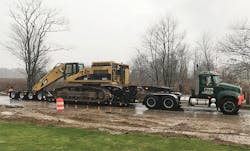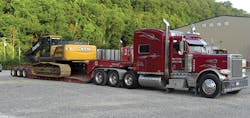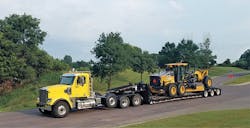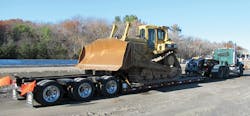Construction equipment that is extremely large or very heavy is the most difficult to load and haul. Machines that are taller or wider are more difficult to load and haul than standard-size machinery, which sometimes requires partial disassembly to meet size and/or weight requirements and can even need to be hauled in multiple loads, says Nathan Uphus, sales manager, Felling Trailers Inc. Even equipment that doesn’t require disassembly still demands “a fair amount of skill” as the loaded truck and trailer combination must not exceed non-permitted load guidelines.
The challenge is that all the equipment today is bigger, wider, taller, and heavier. The trucks are also heavier. Caterpillar and John Deere, in particular, are bigger, wider, and heavier, many trailer manufacturers report. “The 349 is difficult to move,” states Matt Schattgen, director of sales, XL Specialized Trailers Inc, which specializes in over-width, over-height, over-weight custom trailers.
Despite the increasing size and weight of the equipment they haul, customers want lightweight trailers that are designed for heavy equipment and that have the best capacity and the lowest cost. “You can do two of those, but not all three,” cautions Troy Geisler, vice president sales and marketing, Talbert Manufacturing Inc.
In part, because there is no standard capacity for a 55-ton trailer, there’s no “magic bullet.” Geisler says manufacturers should start with questions to “help us spec what the customer needs.”
Those questions include:
- What are you hauling?
- Where are you hauling? Where are you going—what state, on-road or off-road?
- What are you loading?
- What is the weight, height, length, and width of the load?
- What are the dimensions?
- What is your largest load—is it a dedicated or mixed load?
- How many axles?
- Are there any unique loading conditions, such as low ground clearance?
Beyond the Basic Questions
Geisler’s routing question encompasses several aspects. It’s important to check with the state Department of Transportation for pertinent regulations and bridge laws that govern weight, height, width, axle placement, and more. “The issue is permitting,” he summarizes.
In addition to height, width, and weight, regulations also cover ground clearance. The lower, the better, Geisler says—but too low is an issue for railroad crossings.
Load weight includes the trailer and what it’s hauling. Overweight loads can require permits. So, too, can wide loads. Both can also cause rerouting on to suitable roads. Routing can also be impacted by long trailers, Geisler says, due to articulation in the road.
“There are intrastate and interstate regulations for hauling,” points out Jay Kulyk, president, Rogers Brothers Corporation. “The answer to the question with regard to hauling across state lines has as many unique answers as there are state lines to cross.”
When hauling from state to state, there are federal guidelines as well as state rules and regulations, Uphus indicates. Regulations differ, depending on the state. “All states need to adhere to the federal rules and regulations on all federal roadways; however, when the load leaves the federal highway to a state or county highway, the regulations of that particular state take effect.”
Trailer Types
Trailers best suited for hauling heavy construction equipment include the following:
- Flatbed, or platform, trailers feature a flat loading surface with the deck over the tires and no fenders. Available in different lengths, they are suitable for backhoes, forklifts, and skid-steers.
- Step deck, or drop deck, trailers are similar to the flatbed, but is designed for moving equipment that’s taller than the legal height of 8 feet and 6 inches and has a very concentrated load center. Most can carry equipment up to 10 feet and 6 inches without over-dimensional permitting.
- Double drop deck trailers feature an upper deck in the front and another deck in the rear, with the middle section referred to as the well. Some can carry loads up to 12 feet tall. The drop-side deck has main beams at full depth, with lower sides, for machines large enough to straddle the middle. Wheel wells in a drop-side deck can be as much as 4 inches deep, providing more overhead clearance for rubber tire machines like articulated trucks and cranes. It comes in as low as a 15-inch deck height.
- Removable gooseneck (RGN), also known as double drop deck or lowboy, can haul over-dimensional and overweight loads. The upper deck is detachable. These trailers are excellent for carrying both tall and heavy loads. They’re able to carry up to 150,000 pounds, depending on the number of axles the trailer has, and range anywhere from three axles up to 20 axles. The maximum legal well length of an RNG trailer is 29 feet, and the maximum legal freight height is 11 feet and 6 inches. They have a maximum width of 8 feet and 5 inches—the standard for most trailers; any larger requires additional permits.
- Lowboy trailers are commonly used for heavy construction equipment, carrying from 40,000 pounds to 80,000 pounds, depending on the number of axles. The lowboy’s biggest advantage is its 12-foot freight height and overall load height of 14 feet.
- Extendable double drop, or stretch RNG, trailers range from 29 to 65 feet for carrying loads of excessive weight and height that can’t be transported by a regular double drop trailer or RNG. Loads range from 42,000 pounds to 150,000 pounds and may require additional axles above the minimum of three.
“The deck is the belly of the trailer,” proclaims Geisler. Each type of deck—level, beam, extendable, drop—offers advantages for hauling different types of equipment.
How Low Can You Go?
Loaded deck height is critical when hauling tall equipment. Not only does the lowboy’s low deck keep equipment under the height restrictions in most cases, but it also keeps the center of gravity down.
Standard loaded deck height used to be 23 inches; now it’s 20 inches—and some manufacturers go as low as 18 inches or even lower. Kulyk says that’s particularly important in New England and the mid-Atlantic, where following the trend to get the overall height low enough to go under older bridges and other infrastructure is crucial.
Lowboys facilitate the hauling of large earth-moving machines. “The very profile of a lowboy trailer, which is now taken for granted, was invented as a solution to the hauling of taller construction machines, as well as to make them easier and safer to load on and off the trailer,” says Kulyk.
Ground clearance has also evolved. On a trailer with a 23-inch deck height, the standard was 6–8 inches; today, it’s 6 inches with 20-inch deck height. “That leaves 14 inches of structural beam depth—and some manufacturers do a 12-inch beam,” notes Kulyk.
There are engineering principles that restrain design, such as material strength and deflection, or how much the frame sags when loaded. High-strength steel is used, but Kulyk points out that all steel fatigues at the same pace. The more it bends, the faster it wears out. “There are three ways to combat deflection,” he explains: “depth of the structural member—the taller the beam, the less deflection; mass—more weight, a taboo subject; and camber—add arch. A 55-ton with an 18-inch deck height could be six to eight inches taller unloaded.”
One drawback of the detachable lowboy is limited usable deck space. Most 53-foot lowboys have only 24- to 26-foot load areas, which may restrict the hauler to carry one piece of equipment at a time.
For easy rear loading, fixed gooseneck lowboys are a good choice. Rogers’ use high-strength steel, have low deck heights but high ground clearance, and have spacious decks with 25- and 35-ton capacity.
Detached
Nevertheless, detachables are possibly the most popular trailers for hauling heavy construction equipment because of their low deck height and the ease of loading onto the deck, which is on the ground when detached. “You simply drive on and off using ramps or wedges,” explains Kulyk.
The lowboy is a good choice for wide machines, machines that need a low approach angle, and equipment that would struggle with overhead clearance on a single drop.
To make loading even easier, Rogers Trailers offers the Croucher with its front slope design on the platform decks of their detachable gooseneck trailers that tapers the depth of the front portion of the main beams and side members on the top and bottom for a smooth load angle of 8–10 degrees (versus 15–20).
Pioneered in the 1960s to ’70s, the Croucher also features beam hooks on the trailer frame that are positioned at or below the front slope profile to assist easier loading of rollers and track machines. “We use hooks to connect the neck and the deck,” elaborates Kulyk. Because it does not protrude into the center of the deck, it’s easier to load because there’s more clearance.
Detachables get the gradient lower, with almost no slope, which benefits paving equipment in particular. The downfall, according to Amanda Dodd, marketing, Interstate Trailers Inc., is that they need skilled operators for backing. Another concern is that because there are more moving parts, there are more possibilities of breaking down. And, of course, she says the choice of a detachable depends on the application.
Detachable gooseneck lowboys can be hydraulic or mechanical. Hydraulic models use hydraulic cylinders to lower the deck for attaching. They tend to be more forgiving and are popular because they’re easy to load and they keep the center of gravity low. However, weight is an issue because they need a tractor that has a wet kit or a power pack kit to make the trailer self-contained, which adds weight.
There are different designs of mechanical goosenecks, but both are simpler than their hydraulic counterpart. Although they don’t use the tractor’s hydraulics to operate, they need to be blocked and even then can settle into soft ground. Without a winch, it’s difficult to hook up a trailer that has settled.
Slide
No matter how popular the lowboy detachable trailer remains, a single-drop ground-loading, traveling axle trailer is capable of hauling most construction equipment without height restrictions. And, thanks to a longer deck, it can also haul multiple pieces of equipment in one trip.
On a sliding axle trailer, the axle hydraulically slides forward to lower the back of the bed to the ground, negating the need for ramps. It produces a very low load angle for low ground clearance equipment, such as scissor lifts and pavers, which typically require a 6-degree load angle. It also provides maximum deck space because the entire deck is above the tires.
That advantage is offset by its height and center of gravity. Another disadvantage is weight. Because the undercarriage and suspension are built as a separate unit, then mounted to the mainframe on a trailer, there are a lot of moving parts, making the trailer heavy and not the best choice for permitted loads.
Custom Design
Dealers carry what is proven in their region, whether that’s stock trailers, custom trailers, or specialty trailers. Rogers Brothers carries a mix of standard and custom trailers—production models with pre-defined dimensions. “We have offered a line of standard spec trailers since the 1960s,” reminisces Kulyk, “but it didn’t last because every customer has unique needs.”
Rogers works with the customer and tailors the trailer to their needs. “It’s a complex picture,” says Kulyk, adding that customer feedback is responsible for design changes.
The engineering department takes that feedback and creates a trailer to meet the customer’s demands. When it comes to carrying capacity, Dodd says that the engineers at Interstate Trailers can “draw the specific equipment to get the transfer of weight accurate and mark the trailer where the wheels should be.”
Where is the weight? Is it front-heavy or back-heavy? Generally, trailers built to haul construction equipment are designed to haul a multitude of different pieces up to a certain size and weight. After the trailer is designed to haul a piece or pieces of equipment, the full CAD model is put through a series of simulated testing exercises to mimic both static and dynamic loads. But, says Felling’s Uphus, there are some instances where the trailers are designed for a specific piece of equipment or load case.
Most trailers are multi-use, Dodd concurs, but some are single-use. Although Interstate is known for tilt trailers that typically haul mid-size equipment, they also manufacture beam trailers for track machines. Those are offered with custom options to suit their customers’ needs. For example, Dodd says that Asplundh recently purchased 40 DLAs—dual-tired, airbrake, low-profile tire trailers—with the main beams “cut down” due to the height of their equipment. They also feature 2 feet of extra length on their decks because “backhoes are getting bigger and heavier. John Deere [machines] are back-heavy, so it’s nice to have extra space when hauling them.”
Rogers also builds beam decks for really large machines. Kulyk describes how easy they are to load because they drop to the ground for the equipment to drive on. Kulyk says there is cribbing under the machine before it raises the undercarriage.
The gentle riser deck also enables easy loading with its transition frame. The gradual 16-degree angle incline from the trailer’s platform deck to the rear frame (compared with others at 30 degrees) is particularly beneficial for pavers.
Specialty Trailers
Interstate trailers destined for the West Coast have different axle placement to conform to regulations, but some popular features are optional, such as extra D rings for additional tie-downs, tool box lids, and dual speed jacks.
XL trailers for the West coast, such as the MGX: Lightweight, use trunnion suspension and a short stub 16-tire axle. Kingpin settings are compliant with California’s kingpin law. The lightweight design aids compliance with new laws in Texas, Arizona, and New Mexico while providing impressive payload capacity.
Cylinders in the back end slide to expand the rear deck from 102 inches to 120 inches wide for better weight distribution. “One foot in the deck can be the difference in getting a load or not,” explains Schattgen, adding that just 6 inches in load height or width can add 30 miles to a trip. However, while they try to lighten the trailer or have a new configuration, using expanders, they must be careful not to go over length in Texas. “Every state has different axle laws.”
Loading scrapers and other equipment is made easier because the gooseneck fenders double as loading ramps. A 5-foot bucket well with a plate on the bottom enables excavators to ride low.
Schattgen sees the biggest interest in low deck height and low weight. Typically, the lighter weight trailers must compensate with a taller beam, raising the deck height. He remains coy about how XL achieves the low height on their lightweight trailers.
XL also offers a new 15-inch hydraulic detachable trailer with the lowest deck height in a production model, according to Schattgen. “When you go lower, it’s easier to load because the angle of approach is less.” He equates the 5-inch with a paver trailer for low load angle.
It’s particularly beneficial on the east coast, where height issues are common. “It enables them to get around the infrastructure without permits or detours.” The trade-off is low ground clearance, so you have to be more careful when loading and unloading. “It operates the same as a traditional detachable trailer, but it can be difficult to hook up.”
Versatility
Schattgen proudly says, “There are very few types of equipment we can’t haul.” He adds that XL’s standard trailers, with their 85-ton capacity, can “move anything from a D-10, down.” They haul a lot of excavators, he notes, adding that rock crushers and cranes require more customization than any other equipment.
“We design for the customer,” continues Schattgen. They first get the specs on the machine and the truck and then determine the route or states it will be hauling in so they’re aware of permitting requirements. And, he points out, “you have to get the trailer from the factory to the customer, even if most work in a 2- to 3-state range, so it’s important to check on permitting.”
Most construction companies have a multitude of equipment, so trailers need to be as versatile as possible. “If you set up a trailer for one piece of equipment, it pigeonholes you,” believes Schattgen.
On the other hand, picking the right trailer for the job can be more efficient. The hardest equipment to load is the wrong equipment, Geisler says. “If the trailer is built for large excavators, but you’re hauling light and medium duty equipment, it’s hard to load. The smallest load could be the hardest because the trailer may not be designed for some equipment. You need to know the entire puzzle.”
Heavy haul is all-encompassing. Finding the right trailer is a battle to find the correct mix of weight, price, and lifetime for the most utility, Kulyk sums up.
Ultimately, Uphus says, “proper equipment and operator experience are key to moving large equipment.” Everyone agrees that skilled, experienced operators are essential for hauling large equipment on any type of trailer.
It goes hand-in-hand with safety, which is one of Talbert Manufacturing’s core values, along with durability. “Safety is based on static conditions (fully loaded, not moving) and dynamic conditions (fully loaded, moving 60 miles per hour),” elaborates Geisler. “Never compromise on safety.”






